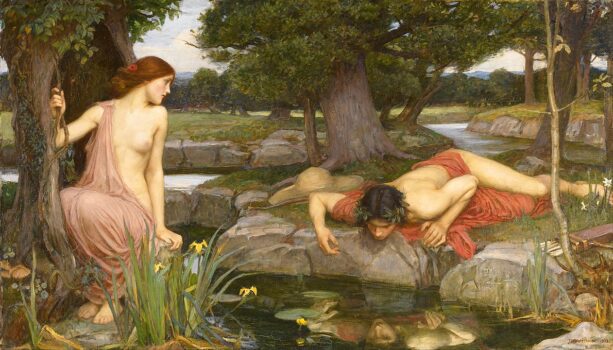The Unreal Story of Echo and Narcissus: Goddess In False Paradise
In a dimly lit Art room within the walls of the Walker Art Gallery in Liverpool, England, a hauntingly painting captures the sorrow of love unreturned. Entitled Echo and Narcissus (1903), the work of the British Pre-Raphaelite painter John William Waterhouse freezes a moment of deep emotional tension, inspired by a tale as old as myth itself. Painted in Waterhouse’s signature romantic style, the canvas is more than just a visual feast; it is a poetic reflection on love, loss, vanity, and silence. But what is happening in this painting? What story lies behind the forlorn girl and the beautiful, transfixed boy?
Let us travel back, past the brushstrokes and colors, into the myth itself.
What Is Happening in Echo and Narcissus’s Painting?
The painting depicts a pivotal moment from Greek mythology, specifically from the Roman poet Ovid’s Metamorphoses. The myth tells of Echo, a mountain nymph, and Narcissus, a careless wise young man who is not concerned about what is happening of those around him.
In Waterhouse’s interpretation, Echo lies on the grass, gazing sorrowfully at Narcissus, who is kneeling at the edge of a still pond, enraptured by his own reflection. The surrounding forest is dim, the atmosphere hushed, and yet alive with subtle tension. Narcissus appears lost in the shimmering surface of the water, utterly unaware of the nymph’s presence, her pain, or her love.
Echo’s body language is telling, her arms rest loosely, her head droops in quiet resignation. Her expression is that of yearning and heartache. Despite her proximity to Narcissus, she is entirely invisible to him. The flowers that dot the scene, particularly the white narcissi by the water, are symbols of the boy’s fate and a quiet nod to the metamorphosis that is to come.
This moment, silent yet emotionally thunderous, is the essence of Waterhouse’s genius. He chooses not to depict the dramatic end of the myth, but rather the tension-filled moment where everything is felt, yet nothing is said.
The Myth Behind the Canvas: Who Were Echo and Narcissus?
According to Ovid, Echo was a nymph who was once full of voice and music. She was cursed by Hera, queen of the gods, to only be able to repeat the last words spoken to her. This happened after Echo distracted Hera with long-winded conversations while Zeus was having affairs with other nymphs. Enraged, Hera took away Echo’s voice, leaving her only with the ability to mimic others.
Meanwhile, Narcissus was born of the river god Cephissus and the nymph Liriope. A seer prophesied that Narcissus would live a long life, if he never recognized himself. With striking beauty, he grew into a youth admired by all, yet he was proud and cruel, rejecting all affections with indifference.
When Echo first saw Narcissus hunting in the woods, she fell hopelessly in love. But her curse made it impossible to speak to him first. She followed him, desperately longing for his attention. When he finally called out, “Is anyone here?”, all she could do was repeat, “Here… here… here…”
After a brief, tragic interaction in which she tried to embrace him and was coldly rejected, Echo fled into the woods. Her body withered away with grief until only her voice remained, echoing in valleys and hills.
Narcissus, however, received poetic justice. He came upon a pool of water, saw his reflection, and fell in love with it, unaware it was only an image. Unable to look away, he eventually pined away and died. The gods, in their twisted compassion, transformed his body into the narcissus flower, which still bends toward the water.
What Is the Moral of the Story of Echo and Narcissus?
The myth of Echo and Narcissus, while ancient, carries timeless moral lessons:
The Dangers of Vanity: Narcissus becomes a cautionary figure about the peril of excessive self-love. His inability to look beyond his own reflection renders him blind to the world around him, including the affections of Echo. His narcissism leads to isolation, obsession, and ultimately, death.
The Pain of Unrequited Love: Echo represents the heartbroken lover who can neither express her feelings fully nor be heard in her own voice. Her tragedy lies in her inability and silence. She is a symbol of those who love deeply but are never noticed, and whose voices are lost in longing.
The Need for Connection: Both characters are ultimately alone. Narcissus loves only himself, and Echo can only mimic others. Their fates are mirror images, each trapped in a prison of self and absence.
Be Careful What You Ignore: Narcissus ignores the emotions of others and becomes a prisoner to his own reflection. Echo ignores her own needs, fixating on someone who cannot love her back. The myth warns against emotional blindness and the refusal to see or hear others.
What Does Echo and Narcissus Symbolize?
Beyond its surface-level narrative, the myth and Waterhouse’s painting offer rich symbolism:
Echo as a Symbol of Lost Voice: Echo’s curse of repetition symbolizes the loss of individual expression. In modern contexts, she can represent people who feel voiceless in relationships, societies, or systems where they are heard only as an echo of others’ desires or words.
Narcissus as a Symbol of Self-Obsession: His story gave birth to the term “narcissism,” now a psychological term describing excessive self-focus, lack of empathy, and admiration of one’s own image. He is the archetype of someone who cannot love others because he is consumed by himself.
The Pool as a Mirror: The reflective water symbolizes the illusion of self-awareness. It draws attention to the difference between seeing oneself and truly knowing oneself. Narcissus sees only the surface, never realizing that his love is based on illusion.
Flowers and Withering: The narcissus flower blooming at the end of Narcissus’s story becomes a symbol of ephemeral beauty and the way passion can turn into decay. Echo, too, withers away in grief, becoming an ephemeral sound.
Waterhouse paints these symbols with care, placing Echo at the fringes of the canvas, blending into nature, while Narcissus occupies the center, yet blind to his surroundings.
What Is the Problem Between Echo and Narcissus?
The core of their conflict lies in disconnection and imbalance:
Echo’s Love is Silent: She cannot express her feelings in her own voice. Her desire is bound in helplessness, reduced to repeating the words of others. She yearns to be seen and loved, but cannot bridge the gap of communication.
Narcissus’s Love is Self-Directed: He cannot love anyone but himself. Though many fall for him, he gives nothing in return. He lacks empathy, never considering the emotional world of others.
Thus, the problem is unreciprocated love caused by an inability to communicate and an unwillingness to understand. Echo cannot speak authentically, and Narcissus will not listen or see beyond himself. They are trapped in a dance of desire and ignorance.
This toxic imbalance mirrors many real-world emotional dynamics, where one person gives everything and the other takes nothing in return, not out of cruelty, but from an inward blindness.
Where Is the “Echo and Narcissus” Painting Now?
John William Waterhouse’s Echo and Narcissus is part of the collection at the Walker Art Gallery, located in Liverpool, England. This gallery, part of the National Museums Liverpool, holds a rich collection of 19th-century art and is celebrated for its Pre-Raphaelite works.
Waterhouse, who was deeply influenced by the Pre-Raphaelite Brotherhood, created this painting in 1903, during the final phase of his career. It stands among his most emotionally resonant mythological works, alongside others like Hylas and the Nymphs and The Lady of Shalott.
Waterhouse’s Artistic Vision
John William Waterhouse is renowned for capturing complex emotional moments from mythology and literature. In Echo and Narcissus, he balances mythological grandeur with intimate sorrow.
The use of natural tones, muted greens, browns, and whites, creates a dreamlike serenity.
The light falls not on the pool or Echo but seems diffused, as though the forest is dimming in response to Echo’s pain.
The figures are poised but not frozen; there is a subtle motion in their gestures, especially in the contrast between Echo’s stillness and Narcissus’s forward-leaning fascination.
Waterhouse doesn’t condemn either character. He presents them as tragically human, caught in the inevitability of their fates.
Modern Relevance of the Myth
In today’s world, the story of Echo and Narcissus has profound psychological and cultural relevance.
In Relationships: The dynamic of loving someone who is emotionally unavailable or self-absorbed is all too common. Echo becomes the archetype of the empath, the person who feels too much. Narcissus represents the avoidant, emotionally distant partner.
In Society: Echo symbolizes people whose voices are ignored or who are reduced to repeating dominant narratives, be it in media, politics, or relationships.
In Mental Health: The story gave rise to the term Narcissistic Personality Disorder (NPD), recognized in psychology. It highlights the danger of unchecked self-admiration and the need for empathy in human interaction.
Waterhouse’s painting, then, is not just a mythological reflection, it is a mirror to our own emotional landscapes.
A Story Written in Silence and Reflection
Echo and Narcissus by John William Waterhouse is a painting that transcends its visual beauty. It captures a mythological story whose emotional depth continues to resonate through centuries. The painting tells of two beings who are doomed to love in vain, one unable to speak her truth, the other unable to see beyond himself.
Their story is a mirror we all might stare into at some point: a reflection on the nature of love, communication, identity, and the dangers of losing oneself, whether in another or in the echo of one’s own image.
Waterhouse’s canvas remains still, but the emotions it stirs are anything but. In the silent woods beside a still pool, two souls pass each other like shadows, one looking out, the other looking in, each alone in a world of their own reflections.




